What is Ryaltris?
Ryaltris is a prescription nasal spray that contains 2 medicines, olopatadine hydrochloride, an antihistamine, and mometasone furoate, a corticosteroid. Ryaltris is used to treat symptoms of seasonal allergies in people 12 years of age and older.
It is not known if Ryaltris is safe and effective in children under 12 years of age.
What is the most important information I should know about Ryaltris?
Important: For use in your nose only. Do not spray Ryaltris into your eyes or mouth.
Who should not use Ryaltris?
Do not use Ryaltris if you are allergic to olopatadine hydrochloride, mometasone furoate monohydrate, or any of the ingredients in Ryaltris. See the end of this Patient Information leaflet for a complete list of ingredients in Ryaltris. Ask your healthcare provider if you are not sure.
What should I tell my healthcare provider before using Ryaltris?
Before you use Ryaltris, tell your healthcare provider about all of your medical conditions, including if you:
- have had recent nasal sores, nasal surgery, or nasal injury.
- have eye or vision problems, such as cataracts or glaucoma (increased pressure in your eyes).
- have tuberculosis or any untreated fungal, bacterial, viral infections, or eye infections caused by herpes.
- have been near someone who has chickenpox or measles.
- are not feeling well or have any other symptoms that you do not understand.
- are pregnant or plan to become pregnant. It is not known if Ryaltris will harm your unborn baby.
Talk to your healthcare provider if you are pregnant or plan to become pregnant. - are breastfeeding or plan to breastfeed. It is not known if Ryaltris passes into your breast milk.
Talk to your healthcare provider about the best way to feed your baby while using Ryaltris.
Tell your healthcare provider about all the medicines you take, including prescription and over-thecounter medicines, vitamins, and herbal supplements.
Especially tell your healthcare provider if you take:
- certain medicines for HIV (such as ritonavir, atazanavir, indinavir, nelfinavir, and saquinavir)
- cobicistat-containing products
- certain antifungals (such as ketoconazole or itraconazole)
- certain antibiotics (such as clarithromycin and telithromycin)
- certain antidepressants (such as nefazodone)
Ryaltris and other medicines may affect each other, causing side effects.
Know the medicines you take. Keep a list of your medicines and show it to your healthcare provider or pharmacist when you get a new medicine.
How should I use Ryaltris?
- Read the Instructions for Use at the end of this Patient Information leaflet for information about the right way to use Ryaltris.
- Ryaltris is for use in your nose only. Do not spray it into your eyes or mouth.
- Use Ryaltris exactly as your healthcare provider tells you to use it.
- If a child accidentally swallows Ryaltris or you use too much Ryaltris, call your healthcare provider or go to the nearest hospital emergency room right away.
- See your healthcare provider regularly to check your symptoms while using Ryaltris and to check for side effects.
What should I avoid while using Ryaltris?
- Ryaltris can cause sleepiness or drowsiness. Do not drive, operate machinery, or do anything that needs you to be alert until you know how Ryaltris affects you.
- Do not drink alcohol or take any other medicines that may cause you to feel sleepy while using Ryaltris.
What are the possible side effects of Ryaltris?
Ryaltris may cause serious side effects, including the following:
- nose and throat problems. Symptoms of nose and throat problems may include:
- nosebleeds
- sores (ulcers) in the nose
- hole in the cartilage between your nose (nasal septal perforation). Symptoms of nasal septal perforation may include:
- crusting in the nose
- nosebleeds
- runny nose
- whistling sound when you breathe
- slow wound healing. You should not use Ryaltris until your nose has healed if you have a sore in your nose, if you have had surgery on your nose, or if your nose has been injured.
- thrush (Candida), a certain fungal infection in your nose and throat. Tell your healthcare provider if you have any redness or white-colored patches in your nose or mouth.
- eye problems, including glaucoma or cataracts. You should have regular eye exams when using Ryaltris.
- allergic reactions. Call your healthcare provider or get emergency medical care if you get any of the following signs of a serious allergic reaction:
- wheezing
- rash
- hives
- swelling of your face, mouth, and tongue
- breathing problems
- immune system problems that may increase your risk of infections. Taking medicines that weaken your immune system makes you more likely to get infections. These infections may include tuberculosis (TB), ocular herpes simplex infections, and infections caused by fungi, bacteria, viruses, and parasites. Avoid contact with people who have contagious diseases, such as chickenpox or measles, while using Ryaltris. If you come in contact with someone who has chicken pox or measles call your healthcare provider right away. Symptoms of infection may include:
- fever
- aches or pains
- chills
- feeling tired
- adrenal insufficiency. Adrenal insufficiency happens when your adrenal glands do not make enough steroid hormones. Symptoms of adrenal insufficiency can include:
- tiredness
- weakness
- nausea
- vomiting
- low blood pressure
- slowed growth in children. A child’s growth should be checked regularly while using Ryaltris.
- sleepiness or drowsiness.
The most common side effects of Ryaltris include the following:
- unpleasant taste
- nosebleeds
- nasal discomfort
Tell your healthcare provider if you have any side effects that bother you or that do not go away. These are not all of the possible side effects of Ryaltris. For more information, ask your healthcare provider or pharmacist.
Call your doctor for medical advice about side effects. You may report side effects to FDA at 1-800-FDA-1088.
General information about the safe and effective use of Ryaltris
Medicines are sometimes prescribed for purposes other than those listed in the Patient Information. Do not use Ryaltris for a condition for which it was not prescribed. Do not give Ryaltris to other people, even if they have the same symptoms that you have. It may harm them. You can ask your healthcare provider or pharmacist for information about Ryaltris that is written for health professionals.
How should I store Ryaltris?
- Store Ryaltris upright with the dust cap on at room temperature between 68°F to 77°F (20°C to 25°C).
- Do not freeze or refrigerate.
- Safely throw away medicine that is out of date or no longer needed.
- Throw away your Ryaltris bottle after using 240 sprays after the first priming. Even though the bottle may not be completely empty, you may not get the correct dose of medicine if you continue to use it.
Keep Ryaltris and all medicines out of reach of children.
What are the ingredients in Ryaltris?
Active ingredients: olopatadine hydrochloride and mometasone furoate monohydrate
Inactive ingredients: benzalkonium chloride, carboxymethyl cellulose sodium, dibasic sodium phosphate heptahydrate, edetate disodium, hydrochloric acid, microcrystalline cellulose, polysorbate 80, sodium chloride, sodium hydroxide, and water for injection.
For more information, go to www.RYALTRIS.com or call Hikma Specialty USA Inc. at 1-800-962-8364.
Instructions for use for Ryaltris
Ryaltris (rye - al’ - tris)
(olopatadine hydrochloride and mometasone furoate monohydrate nasal spray)
Important: For use in your nose only. Do not spray Ryaltris into your eyes or mouth.
Read the Instructions for Use before you start to use Ryaltris and each time you get a refill. There may be new information. This Instructions for Use does not take the place of talking with your healthcare provider about your medical condition or treatment. Before you use Ryaltris, make sure your healthcare provider shows you the right way to use it. Shake the bottle well before each use.
Your Ryaltris nasal spray bottle (See Figure A)
Figure A
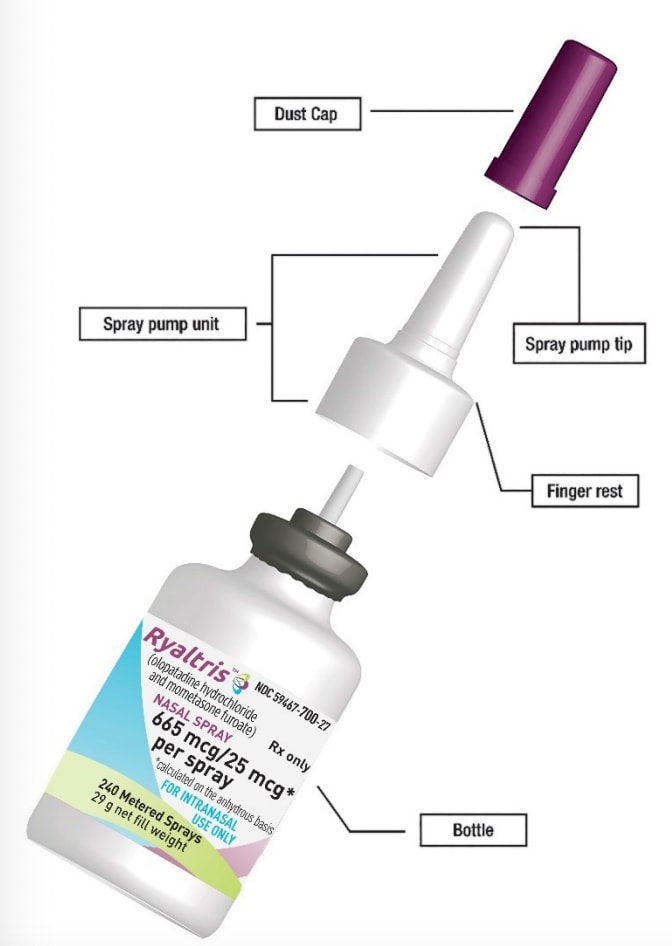
Preparing the nasal spray bottle
Your Ryaltris nasal spray must be primed before you use it for the first time and when you have not used it for 14 days or more.
Priming your Ryaltris pump before first use
Before you prime the bottle, shake the bottle well.
Step 1. Remove the dust cap.
Remove the dust cap from the spray pump tip of the bottle. (See Figure B)
Figure B
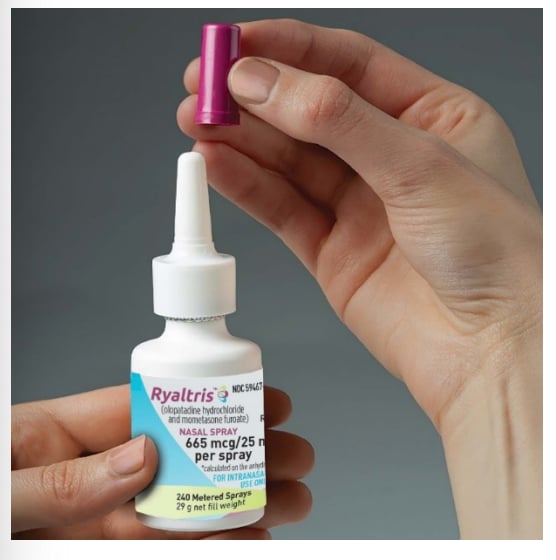
Preparing the nasal spray bottle
Step 2. Hold the nasal spray bottle firmly and upright with your index and middle finger on either side of the applicator (on finger rests) while supporting the grooved base of the bottle with your thumb.
Step 3. Before first use, push down on the pump quickly and firmly 6 times, releasing the spray into the air, away from the eyes and face until a fine mist appears. (See Figure C)
Figure C
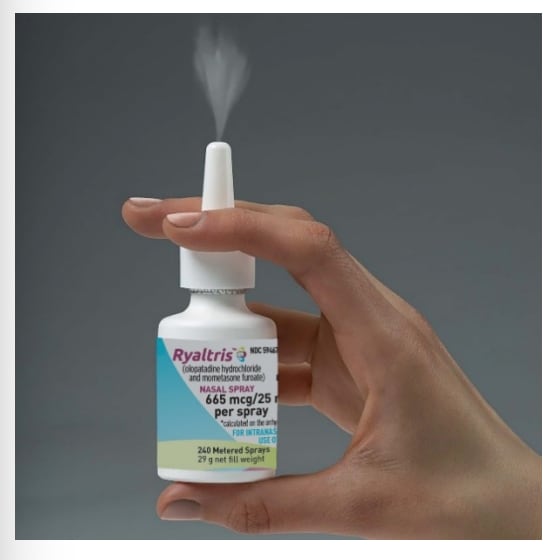
If you do not use Ryaltris for 14 or more days, you will need to shake the bottle well, and prime the pump with 2 sprays or until a fine mist appears.
Your Ryaltris is now ready for use.
Using your Ryaltris
Step 4. Gently blow your nose to clear your nostrils. (See Figure D)
Figure D
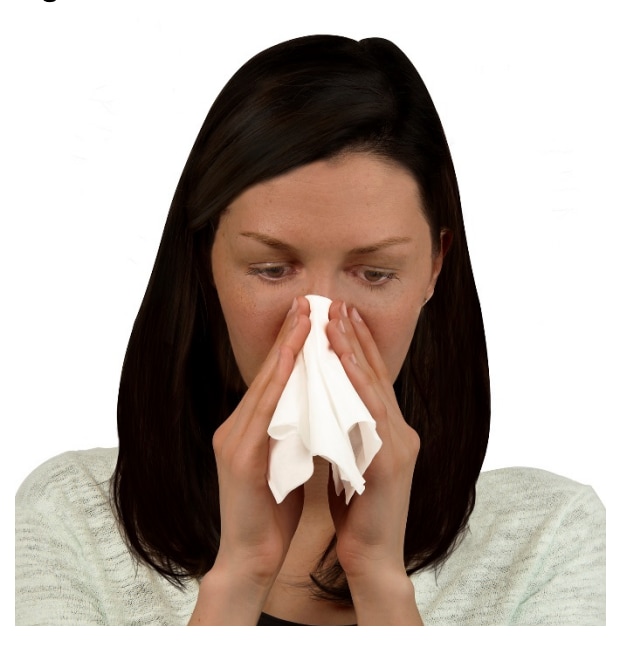
Step 5. Shake the bottle well before each use (morning and evening).
Step 6. Hold the bottle firmly with your index and middle finger on either side of the applicator (on finger rests) while supporting the grooved base of the bottle with your thumb. (See Figure E)
Figure E
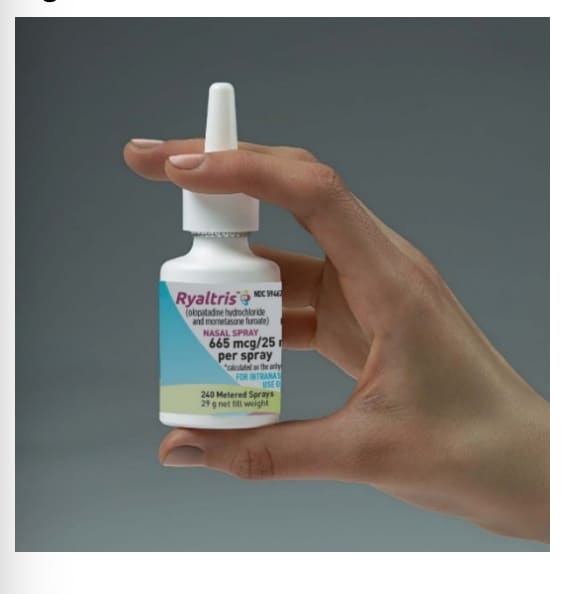
Step 7. Hold 1 nostril closed with a finger. Insert the end of the spray pump tip into the other nostril, pointing it slightly toward the outside of the nose, away from the nasal septum (the wall between the 2 nostrils). (See Figure F)
Figure F
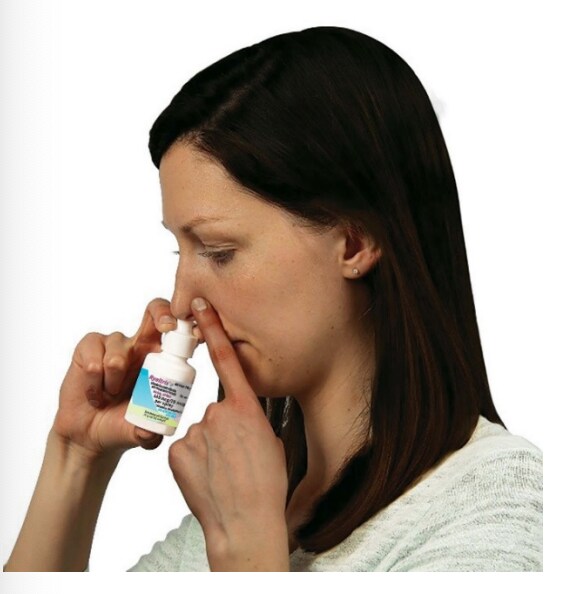
Step 8. Tilt your head forward slightly. Keep the bottle upright and press down one time quickly and firmly on the finger rests to activate the pump. (See Figure G) Breathe in (inhale) gently through your nose as you spray. Then breathe out through your mouth.
Figure G
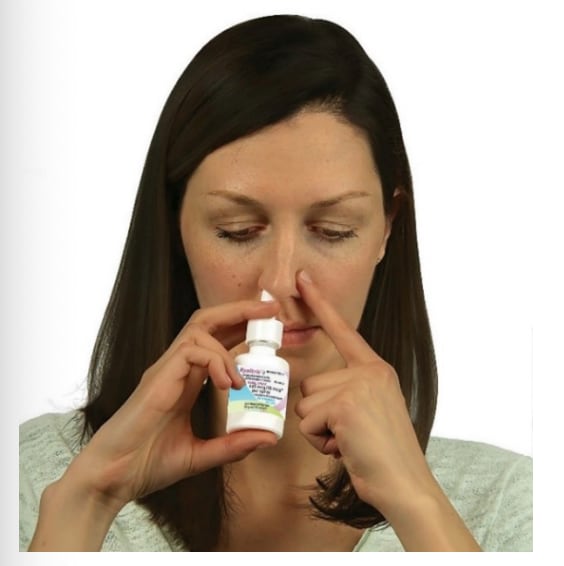
- Try not to get any spray into your eyes or directly on your nasal septum (the wall between the 2 nostrils).
Step 9. Repeat Steps 6 through 8 and deliver a second spray in the same nostril.
Step 10. Repeat Steps 6 through 8 with 2 sprays in the other nostril.
- Do not blow your nose for at least 15 minutes after using Ryaltris, to make sure that you receive all of the medicine.
- Do not tip your head back. This will keep the medicine from going into your throat.
Step 11. Wipe the spray pump tip with a clean dry tissue or cloth. (See Figure H)
Figure H
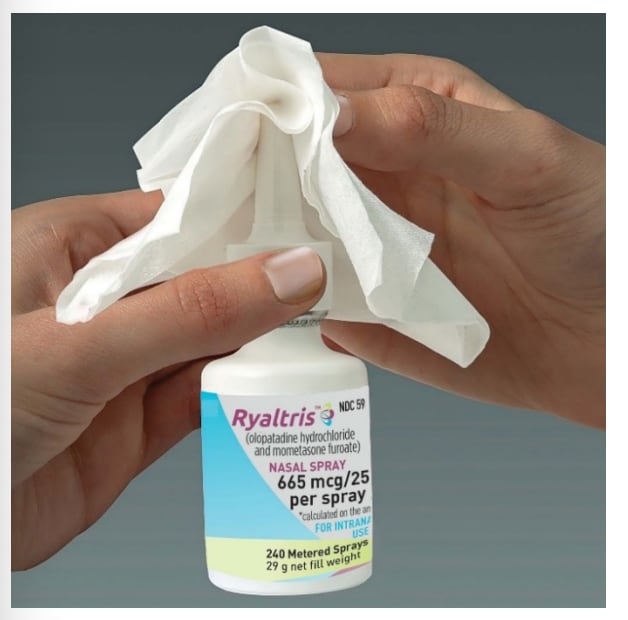
Step 12. Hold the spray pump unit and push the dust cap back on the spray pump tip of the bottle until you hear a click. (See Figure I)
Figure I
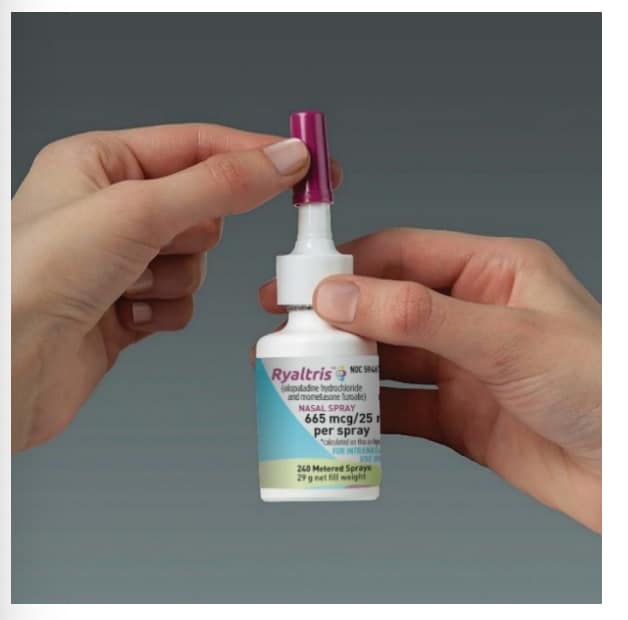
Each bottle of Ryaltris contains enough medicine for you to spray from the bottle 240 times after the first (initial) priming. You should keep track of the number of sprays used from each bottle of Ryaltris. Do not count any sprays used for initial priming of the bottle.
How to clear the Ryaltris spray pump unit if it becomes blocked
Do not try to unblock the spray pump unit by inserting a pin or other sharp object. This will damage the spray pump unit, and you may not get the correct dose of medicine.
Step 13. If the spray pump unit becomes blocked, remove it by gently pulling upward. (See Figure J) Remove the dust cap and place only the spray pump unit in warm water to soak.
Figure J
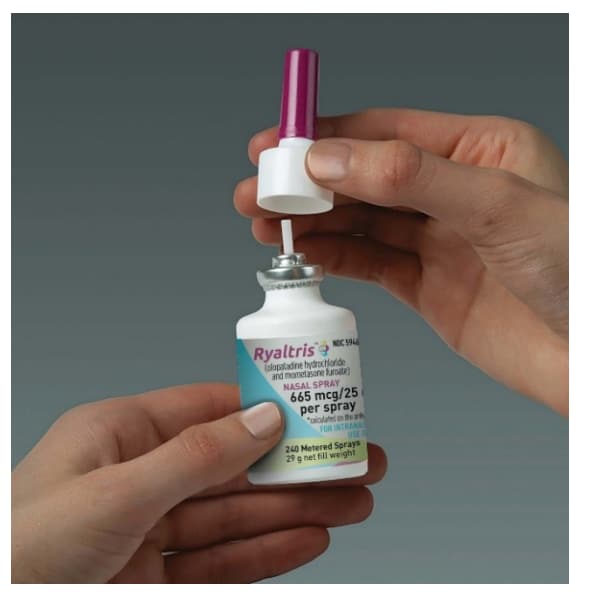
Step 14. After soaking for 15 minutes, rinse the spray pump unit and dust cap with warm water, and allow them to dry completely. (See Figure K)
Figure K
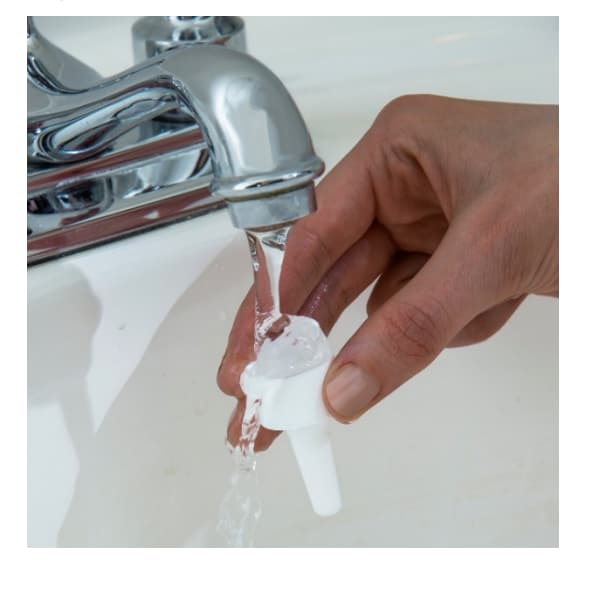
Step 15. Place the dust cap on the spray pump tip and put the spray pump unit back on the bottle. (See Figure L)
Figure L
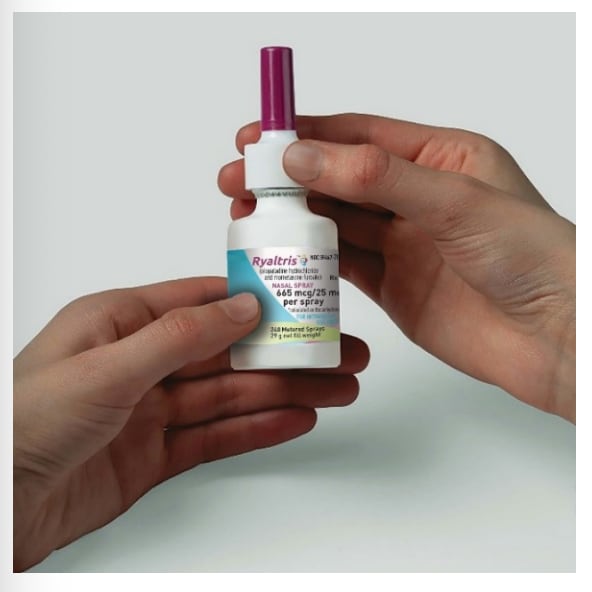
Step 16. After following the steps to clear your blocked spray pump see “Priming your Ryaltris pump before use” section above and re-prime using 2 sprays. Replace the dust cap, and your Ryaltris is ready for use.
Repeat the unblocking steps if needed.
How should I store Ryaltris?
Store Ryaltris at room temperature between 68°F to 77°F (20°C to 25°C).
Do not freeze or refrigerate.
Do not use Ryaltris after the expiration date on the label or the box.
Throw away your Ryaltris bottle after using 240 sprays after first priming. Even though the bottle may not be completely empty, you may not get the correct dose of medicine if you continue to use it.
Keep Ryaltris and all medicines out of the reach of children.
Instructions for use approved 01/2022.




